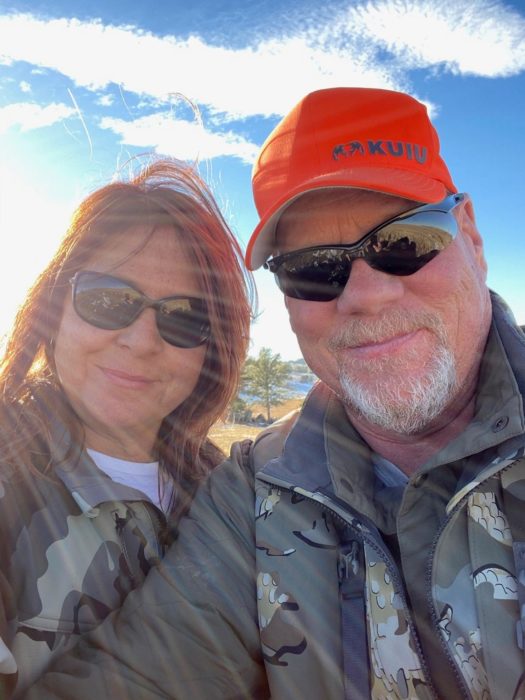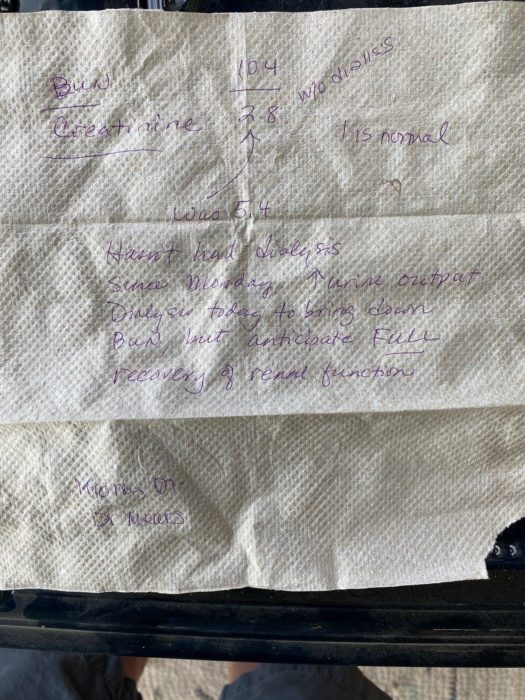Brush with Death: Laramie County Man Survives COVID-19
August 9, 2021

Terri and Garry Carpenter: “We don’t take anything for granted anymore,” said Terri after her husband nearly lost his life to COVID-19.
On January 18, Garry Carpenter flew to Washington, D.C., for work.
Garry and his wife, Terri Carpenter, live near Curt Gowdy State Park, west of Cheyenne.
“We’d been careful about COVID,” Terri said. “We’d go to work and run errands, but we weren’t taking any big risks.”
They both knew that flying to D.C. right before the presidential inauguration wasn’t ideal.
“I took precautions,” Garry said. “But there were so many people in the airport, and they were coming from everywhere.”
Unfortunately, the precautions weren’t enough.
On January 20, the day after he returned home, 56-year-old Garry started to feel sick.
“That’s not Garry,” Terri said. “I knew something was really off. In the 15 years that I’ve known him, the worst thing he’s ever had was a sinus infection.”
Garry looked and felt bad enough that Terri took him to see a doctor.
Garry was tested for COVID-19 and was sent home with medicine to treat his symptoms.
By the next day, Garry was “much worse,” Terri recalled.
“I was on the phone with my daughter, who’s a nurse in a big hospital in Florida and has cared for COVID patients,” she said.
Garry’s temperature was 104 degrees. He was also extremely tired and was having a hard time catching his breath. “When I described his symptoms, my daughter told me to get his things and take him to the hospital right away,” Terri said. “When I told him what we were doing, Garry just nodded. That’s not Garry.”
Garry was quickly admitted to the COVID-19 unit at Cheyenne Regional Medical Center.
Up to that point, Garry had been given three COVID-19 tests, and they’d all come back negative. Kenny, the emergency department nurse who cared for Garry, told Terri that they were going to treat Garry like he had COVID-19. “That fourth test finally did come back positive,” she said.
Over the next week and a half, Garry’s condition got progressively worse.
“My daughter told me what could happen, and that’s exactly what happened,” Terri said. Struggling to breath, “Garry went from a BiPAP to a CPAP to a ventilator.”
Get to the Hospital Right Away
On February 8 Terri got a call from her daughter telling her to get to the hospital right away.
Due to poor cell phone service in the area, Terri had asked the doctors and nurses to provide Garry’s twice daily updates to her daughter, who would then get a hold of Terri.
That day Terri’s daughter called around 8:30 a.m., “earlier than normal,” Terri said. “I could tell something was terribly wrong. She is usually calm, but she was so upset. She couldn’t hold it in.”
Garry’s condition was worse, and he wasn’t expected to live much longer.
Terri, who was weak from her own bout with COVID-19, called a neighbor for help. The neighbor, Darlene Smith, wife of local orthopedic surgeon Dr. Bruce Smith, came over immediately. “On the phone she could barely understand what I was saying,” Terri said, “so she rushed over to find out what was wrong.” Darlene immediately offered to drive Terri to CRMC so that she could be with Garry during his final hours.
When Terri got to Garry’s room, his skin was mottled blue and purple. “He looked like my dad did right before he died,” Terri said. “Thankfully, Pastor Steve [Tims] from the hospital was with me, but other than that, I was alone and knew I had to prepare myself.”
Earlier, Terri and her daughter had called family members to let them know they needed to get to CRMC as quickly as possible. By that night, the family had arrived.
Two by two, family members donned personal protective equipment and entered Garry’s intensive care unit room—to hug him, say goodbye and let him know how much they loved him. And they encouraged and prayed for him, while also preparing themselves for what was likely to come.
When they weren’t in Garry’s hospital room, family members gathered outside to comfort one another and pray.
Garry’s Condition Improves
“At midnight the nurses asked everyone to go home so that Garry could rest,” Terri said.
Garry was sedated and unconscious, but he was likely aware of the activity going on around him, and “he was still holding his own,” Terri said.
The next morning one of Garry’s doctors called, asking if they could start him on dialysis. Clinging to hope, Terri agreed.
Over the next few days, Garry’s condition slowly—and what many would say miraculously—improved.
The next time Terri could visit her husband in person, Garry’s nephrologist, Dr. A. J. Meares “was so excited,” she said.

The note from Dr. Meares highlighting that Garry’s once-failing kidneys would recover.
“Dr. Meares grabbed a napkin and started writing down information while he explained what was happening,” Terri said.
The napkin included a statement that the couple will never forget: “Anticipate FULL recovery of renal function.”
The couple kept the napkin to remind them of that day and its significance.
Up to that point, COVID-19 patients started on dialysis rarely lived for very long, Terri explained.
“I was told that no COVID patient in this community or even the region who had been put on dialysis had survived,” she said.
That day with Dr. Meares was a turning point for Garry.
A short time later, the team decided to see Garry’s response if they decreased his sedation.
“It was a risk,” Terri said. “Most patients don’t do well when they are awake and on a ventilator. They don’t like having that tube down their throats.”
The morning that Garry was eased out of sedation, “he blinked his eyes in recognition and gave everyone a thumbs up,” Terri said. “It was a great day.”
The next step was to take Garry off the ventilator.
The date the team picked was February 20, which also happens to be Garry’s birthday.
“The room was full of people—nurses and doctors and respiratory therapists,” Terri recalled. “I was told that a lot can happen when someone comes off a ventilator so they wanted to be ready.”
Everything went smoothly, and Garry was all smiles once it was over, Terri recalled.
“That was truly a happy birthday!” Terri said, adding that “it was so good to hear Garry’s voice again.”
Six days after the ventilator was removed, Garry was sent by ambulance to a rehabilitation unit in Loveland, CO. He had been at CRMC for close to five weeks.
“There was a celebration in the ICU when he was leaving. All his nurses saw him off,” Terri said. “They had been through so much because of the pandemic and had seen so many sad outcomes. I think this was something that all the nurses and everyone who treated him really needed.”
Garry was extremely weak when he left the hospital. He was unable to walk or even stand. He also had diabetes, an elevated heart rate and high blood pressure, none of which he had before getting COVID-19. He was expected to be in rehabilitation for four to six weeks.
But Garry was determined. He worked hard and walked out of the rehab center three weeks later.
“I really wanted to get back home,” he said.
Fear of Missing Out
Garry spent several more weeks working to regain his strength.
While he’s much better, Garry still has high blood pressure and a higher-than-normal heart rate. He also tires more easily than he did before contracting COVID-19 and has occupational therapy to help recover function in one of his arms.
“After going through something like this, you realize how precious life is,” Terri said. “We don’t take anything for granted anymore. We go for drives in our ’71 Ford and buy ice cream, and we plan to take some of those trips we’ve put off.”
Garry, who loves to hunt and fish and ride his ATV, has spent a lot of time fishing in the reservoirs near his home. At first Terri would go with him. “I almost lost him once,” she said, worried that something might happen to Garry during those first outings.
Garry has now recovered enough that he can go out on his own.
“I think my still being here is partly due to FOMO [fear of missing out],” Garry said. “There’s a big walleye out there that I haven’t caught yet.”
“Why Did I Pull Through?”
Terri and Garry have both gotten a COVID-19 vaccine, and they’ve encouraged all their friends to get one, too.
“We had friends who were sure Garry would recover from this virus without any problems,” Terri said. “They told me he was this big, tough guy and would get over it.”
When their friends heard what Garry went through and saw how much it impacted him and his quality of life, they decided not to take that risk, Terri said. “No one we know wants what happened to Garry to happen to them.”
Looking back, the couple said they are extremely grateful for Garry’s outcome and the people who have cared for him.
“It took him down so fast,” Terri said. “For days every report I got was worse.”
Garry said he sometimes wonders why he lived while so many others who have caught COVID-19 have not survived: “Of all the people who didn’t make it, why did I pull through?”
The couple think it might have to do with all the family members and friends who were praying for Garry.
“We are not religious, but we’re not sure how else to explain this,” Terri said.
Garry and Terri are also grateful to the nurses, doctors and respiratory therapists who cared for Garry.
Terri said that when her daughter, the nurse from Florida, got to CRMC, “she looked everything over and told me, ‘they are doing everything right, Mom.’ ”
“We will never forget them,” Terri said of her husband’s clinical care team. “They are all amazing, and we thank them for working so hard to save Garry’s life.”